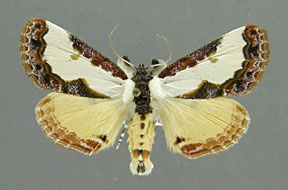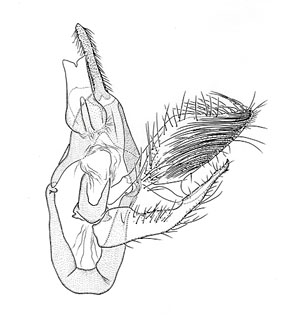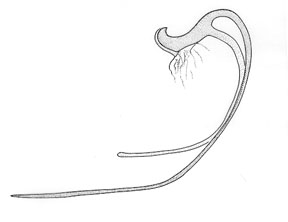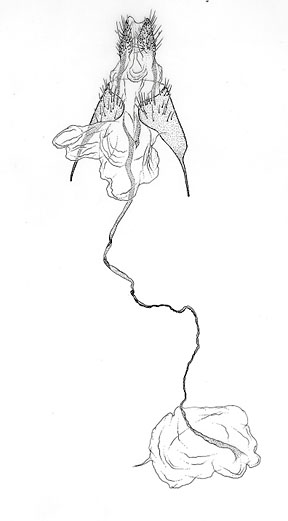|



Male aedoeagus

|
Eudryas Boisduval
Eudryas Boisduval, 1836, Historie Naturelles
des Insectes. Species General des Lépidoptéres, 1:4(plate
explanation).
Type species: Euthisanotia unio Hübner by monotypy.
Cyphocampa Harris, 1869, in Scudder, Occ.
Papers Boston Soc. Nat. Hist., 1:138.
Type species: Bombyx grata Fabricius by monotypy.
Parathisanotia Kiriakoff, 1977, Das Tierreich,
99:76.
Type species: Bombyx grata Fabricius by original designation.
Eudryas is a distinctive genus apparently
most closely related to Xerociris and Gerra. The most
characteristic feature of the three known species the genus is the curious
structure of the male aedoeagus.
- Aedoeagal shaft of male genitalia consisting of a basal portion
with two very long, thin, curved projections; one projection arises
from the middle of the broad portion of the aedoeagal shaft and the
other is the modified apical portion of the aedoeagal shaft with a minute
opening at its apex where the vesica arises; vesica presumably very
small, but impossible to evert.
- Frontal process of head present, but variable between species;
frontal process in the type species (unio) a strong conical
projection with a minute and poorly developed apical ring, the lower
margin of ring projecting as a nose sharped structure.
- Mesoscutum with elongate, rectangular, slightly metallic scales,
formed into a caudal ridge overlapping a massive mesoscutellar tuft
of curled, elongate, slightly metallic scales.
- Male abdomen with a large tuft of curled, slightly metallic
scales on tergum one, with decreasingly smaller tufts on terga two and
three.
- Male valve with clasper rotated downward and outward (in
the orientation of figure), appearing as a projection of the sacculus.
- Female ductus bursae very long and very thin; corpus bursae
round to ovate, extremely membranous; ductus seminalis arising from
the caudal end and no distinct appendix bursae present.
- Larvae feeding on species of Vitaceae and Onagraceae.
|


